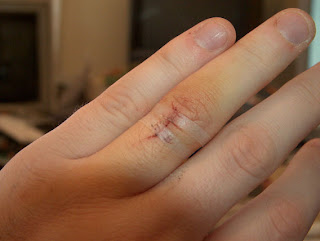This also answers my question as to whether the kernal can move/relocate the main character map screen. The answer is no. This is because located at $d802 and $d81b you'll find a screen line lookup table, with the address of every line on the screen. and $0c00 is encoded into this table. Pitty.
Here's the main parts for anyone interested....
; *************************************************
;
; Clear screen with colour $10
;
; *************************************************
LD87E LDA #$10 ; Colour to clear screen to (black)
STA $053B ; Set current character colour
LDA #$04
STA $0541
; *************************************************
;
; Esc-n SCNCLR
;
; *************************************************
LD888:
JSR LDE70 ; Set full screen window
LD88B JSR LD89A ; Set the cursor HOME
LD88E JSR LD8AA ; Set screen pointers
; *************************************************
;
; Actual Screen Clear
;
; *************************************************
ClearScreen:
LD891:
JSR LDAF7 ; Clear the current line the cursor is on
CPX $07E5 ; At window lower edge?
INX ; move cursor down a line
BCC LD88E ; if not done, clear more
; *************************************************
;
; Set cursor HOME (set to top/left of current window)
;
; *************************************************
LD89A LDX $07E6 ; Get window TOP
STX $CD ; set cursor Y
STX $C4 ; cursor input row
LD8A1 LDY $07E7 ; Get window LEFT
STY $CA ; Set cursor X
STY $C5 ; Set cursor input X
LD8A8 LDX $CD ; get cursor Y
LD8AA LDA ScreenAddressLO,x ; look up screen xply table (LO)
STA $C8 ; store current screen address (low)
LDA ScreenAddressHI,x ; look up screen xply table (HI)
STA $C9 ; store current screen address (HI)
LD8B4 LDA $C8 ; get current screen address LO
STA $EA ; store in current editor COLOUR address LO
LDA $C9 ; now get the screen HI
AND #$03 ; and work out the HI addrews
ORA #$08 ; of the colour screen
STA $EB ; and store in the editor colour address HI
RTS
; *************************************************
;
; Clear the current line the cursor is on.
; (within the left/right window range)
;
; *************************************************
LDAF7 LDY $07E7 ; Get window LEFT edge
JSR LDF4A ; ???
LDAFD JSR LD8AA ; Setup screen addresses
DEY
LDB01 INY
LDA #$20 ; fill character address with spaces ($20)
STA ($C8),y
LDA $053B ; get current colour attribute
STA ($EA),y ; and store in colour address
CPY $07E8 ; right edge yet?
BNE LDB01 ; if not loop
RTS
; *************************************************
; Set window bottom and right
; *************************************************
LDE67 STA $07E5 ; Set current screen window bottom
STX $07E8 ; Set current screen window right
JMP LDE80
; *************************************************
; Reset current text window back to full screen
; (0,0) to (39,24)
; *************************************************
LDE70 LDA #$18 ; Set window bottom to 24
LDX #$27 ; Set window right to 39
JSR LDE67 ; set bottom and right variables
LDA #$00 ; Set window top to 0
TAX ; set window left to 0
; *************************************************
; Set window top and left
; *************************************************
LDE7A STA $07E6 ; Set current screen window top
STX $07E7 ; Set current screen window left
; *************************************************
; Clear screen line wrap table
; *************************************************
LDE80 LDA #$00
LDX #$04
LDE84 STA $07ED,x
DEX
BNE LDE84
RTS




